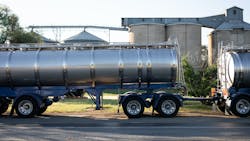Blog: How to make bulk facilities ‘driver-friendly’
Bulk Connection, a bulk freight broker based in Mystic, Connecticut, recently blogged about the importance of establishing “driver-friendly” facilities in which tank trailer loading and unloading goes smoothly, and shared 10 practices that make shippers driver-friendly—and create long-lasting customer-carrier relationships.
“When visiting loading and unloading facilities, bulk freight drivers face many unfriendly hurdles,” Jim Cordock, Bulk Connection owner, wrote in the blog post. “They face long waits to load or unload, onsite accommodations that aren’t all that accommodating, and people that are sometimes less than cooperative.
“When routinely encountered at a given worksite, these negative factors may discourage drivers from wanting to visit the facility in the future. And, if one driver has a bad experience at a specific site, chances are many other drivers will hear about it. So, it stands to reason that if your site—or your customers’ sites—are viewed unfavorably by drivers, it may be more difficult to find drivers willing to visit your site and move your products.”
Cordock correctly points out that freight markets ebb and flow, and when capacity is tight, bulk carriers prioritize relationships with shippers who value their drivers.
And with a driver shortage that continues to worsen, this is true now more than ever.
Here are the best practices Cordock says shippers should follow to ensure tank truck drivers feel appreciated in their facilities:
- Ensure safety and accessibility. Above all else, the most important thing to drivers is that consignees provide a safe, clean, and accessible site. This includes unobstructed pathways for trucks and clear instructions for drivers. Safety equipment for loading and unloading processes should also be provided.
- Assist drivers with staff support. Make sure loading and unloading facilities are staffed and ready to receive the driver upon arrival. Facility employees should perform most of the loading/unloading work while the driver waits with the truck.
- Assist drivers with necessary equipment. Make sure the facility’s equipment is ready. Ensure that hoses, if needed, are readily available, and staff can make the required connections.
- Provide onsite driver amenities. Offer a few amenities to drivers, such as onsite (or nearby) scales and a secure parking lot where a driver can rest while products are being loaded or unloaded.
- Allow bigger windows for shipping and receiving. In terms of appointment windows, the more flexibility shippers can give carriers, the more likely it is that they can fit those loads into their schedules. This includes start- and end-time flexibility, along with longer windows for appointments.
- Open during unconventional hours. While this may be unpopular, operating facilities during “off hours” like nights and weekends can be extremely beneficial when necessary. Carriers operate around the clock, so accommodating their schedules can greatly improve “driver friendliness.”
- Perform efficient trailer inspections. Inspect trailers quickly to minimize waiting times for drivers. This ensures they can make the best use of their valuable hours of service.
- Communicate facility details clearly. Know and communicate the facility’s details and potential issues. Provide information about scales, loading/unloading capacity, appointment systems, and any other relevant details.
- Ensure adequate storage. Make sure silos have room to avoid delays and detentions. A quick way to make an unfavorable impression is to have a driver arrive at the unloading site only to find the storage facility full.
- Be nice and respectful. This one should go without saying, but the biggest strides in becoming a driver-friendly facility often come from treating drivers with respect and courtesy. Ensure staff treats drivers as they’d like to be treated.
“By implementing these practices and maintaining a driver-friendly approach, your facility can stand out in a competitive market, ensuring smoother operations and better relationships with bulk trucking companies,” Cordock concluded.
About the Author
Jim Cordock
Bulk Connection owner
Jim Cordock is the owner of Bulk Connection, a specialized bulk frieght broker formed in 1987 in Mystic, Connecticut.
